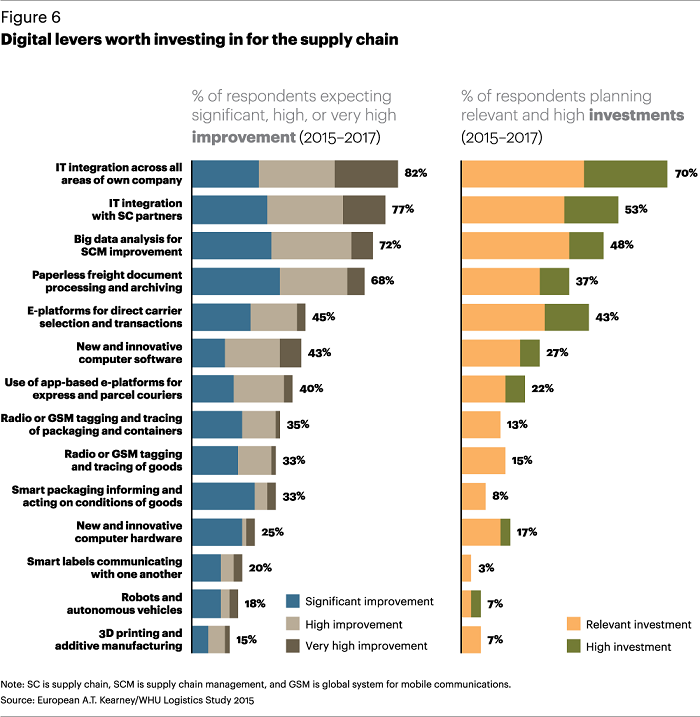
Digitalization of Supply Chains – How to get More Value out of your Supply Chain
For companies ahead of the curve, a huge advantage can be realized when you get it right. Is it expensive? Does it require a huge capital expenditure (CAPEX)? You need to work on people/resources to secure the right competence and availability for change, you need to work on demand and shaping revenues, you got to work on the technology that supports it all, and finally you got to handle risk. These four areas are not necessarily big investment areas, but needs to be orchestrated in the right way. If you do this right, you can experience substantial revenue growth whilst your costs will be reduced at the same time. Which company wouldn’t focus on such projects?
People/Resources
To be able to make the skill shift, you need to skill up. We will see more automated supply chain processes and hence more automated event and risk management. The human eye needs to focus on judging how to deal with exceptions and how to improve to become more competitive, which require more skills. Managing supply chains for more customized demand and supply, with smarter and more dynamic supply chain segmentation, also require more skills.
Other areas requiring skills, as we turn towards extended, expanded and enhanced offerings that go beyond physical offerings, are e.g. increased focus on return logistics, post-sales supply chain services to customers and more usage-oriented pricing with suppliers.
Technology
Roll-out is key and technology must support easy access, standardized systems integration, and maximum connectivity. We’re moving in the direction from human judgement to machine intelligence, but to access and share information we need to integrate IT systems. For many companies, IT systems integration remains a prohibitive task. The aim must be to create conditions for a dramatically lowered complexity and cost for system integration in favor of seamless, flexible and responsive supply chains. This will require global standardization of process work flows, involvement from ERP systems vendors to a much higher degree than today, and real-time data synchronization. What’s promising, is that IT systems integration is a hot topic for European supply chain managers, driving substantial investments in IT integration and hopefully standardization as well.

Shaping demand
Apart from needs such as seamless supply chain integration, real-time synchronization of data, and global standardization, demand sensing through IoT (Internet of Things) and big-data predictive analytics is driving companies’ investments. But as always, it is not the data itself that is critical, it is the ability to pick out the important data, analyzing it, and incorporating it into your ongoing business for planning purposes.
At last, the market and the supporting technologies enable the capturing of true demand. And since the bullwhip effect still prevails, true demand instead of today’s guesswork will provide companies with substantial benefits when acting upon it.
Risk
Increased intertwined and collaborative activities with customers, suppliers, and partners, means growing exposure to digital business risks and crimes. While supply chain digitalization brings obvious benefits, it also means companies will be increasingly vulnerable to system failures, data losses and cyber-attacks. Digital risk is a board-level concern for many companies. It is best handled through regular intelligent review, based on a combination of the threat environment, current technology trends and the current risk management strategy.
Summary
The main benefit of digitalization of your supply chain, is the greater visibility leading to better decision making. One of the greatest obstacles in supply chains today, is the lack of visibility. Improved visibility through digitalization will help many companies throughout supply chains to reduce inventory levels substantially, as well as driving other costs out of the supply chains. In addition, better informed companies have greater flexibility (time-to-act) and that will reduce the risk for supply shortages, disturbances and similar risks.
To reach the benefits of digitalization, companies need to invest in better integrated IT-systems throughout supply chains, capabilities of analyzing big-data, and system-based algorithms for more automated supply chain management. While doing this, companies will have to address the growing exposure to digital business risks and crimes that comes with digitalization.
The extent to which your supply chain management has to transform itself will also depend on whether you as a company has entered the market with a digital business model from the beginning or if you have adopted it later.
Insights

If you are interested in learning more about how to create a powerful connected supply chain, here are our latest insights.
Tech papers

To help you get a deeper and better understanding of our solutions and your supply chain, we have developed a number of detailed tech papers on different subjects.
-
Necessary
These cookies are not optional. They are needed for the website to function. -
Statistics
In order for us to improve the website's functionality and structure, based on how the website is used. -
Experience
In order for our website to perform as well as possible during your visit. If you refuse these cookies, some functionality will disappear from the website. -
Marketing
By sharing your interests and behavior as you visit our site, you increase the chance of seeing personalized content and offers.


